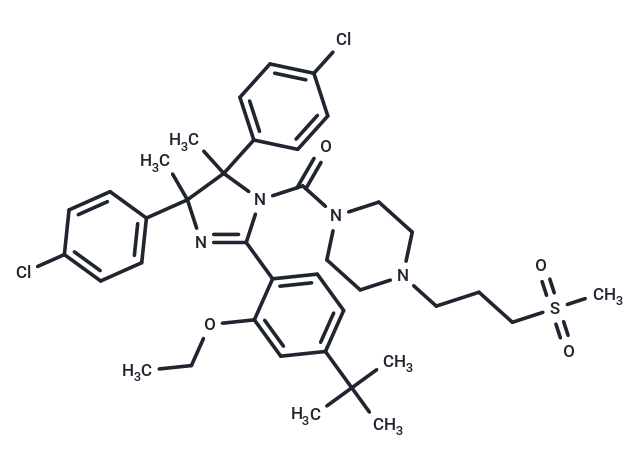Shopping Cart
Remove All Your shopping cart is currently empty
Your shopping cart is currently empty
RG7112 (RO5045337) (RO5045337) is an orally bioavailable and selective p53-MDM2 inhibitor.

| Pack Size | Price | USA Warehouse | Global Warehouse | Quantity |
|---|---|---|---|---|
| 1 mg | $41 | In Stock | In Stock | |
| 2 mg | $59 | In Stock | In Stock | |
| 5 mg | $97 | In Stock | In Stock | |
| 10 mg | $172 | In Stock | In Stock | |
| 25 mg | $343 | In Stock | In Stock | |
| 50 mg | $522 | In Stock | In Stock | |
| 100 mg | $756 | In Stock | In Stock | |
| 500 mg | $1,580 | - | In Stock | |
| 1 mL x 10 mM (in DMSO) | $157 | In Stock | In Stock |
| Description | RG7112 (RO5045337) (RO5045337) is an orally bioavailable and selective p53-MDM2 inhibitor. |
| Targets&IC50 | MDM2:11 nM(Kd) |
| In vitro | In three wild-type p53 (HCT116, RKO, and SJSA1) cell lines, RG7112 selectively and dose-dependently inhibits cell growth. In cancer cells expressing wild-type p53, RG7112 activates the p53 pathway, and induces cell-cycle arrest and apoptosis. RG7112, both alone and combined with Peg-IFNα 2a, significantly decreases MPN colony-forming unit-granulocyte macrophage and burst-forming unit-erythroid numbers and preferentially eliminates the total number of JAKV617F(+) MPN hematopoietic progenitor cells. In addition, in MDM2-amplified liposarcoma cells, RG7112 significantly synergizes with Trabectedin. |
| In vivo | In rats, RG7112 impairs thrombopoiesis via activation of p53. In the SJSA1 xenograft mouse model, RG7112 (200 mg/kg, p.o.) penetrates tumor cells and activate p53 and its 2 major functions, cell-cycle arrest and apoptosis. In nude mice bearing SJSA-1, and MHMn xenografts, RG7112 (100 mg/kg, p.o.) causes tumor regression. |
| Kinase Assay | HTRF assay: Homogeneous time-resolved fluorescence (HTRF) assay measures the signal generated by 2 components when they are in close proximity. The p53–MDM2 binding assay uses a biotinylated peptide derived from the MDM2-binding domain of p53 and a truncated N-terminal portion of recombinant human GST-tagged MDM2 protein containing the p53-binding domain. Proteins for crystal structure studies are expressed in E. coli strain BL21 using the helper plasmid pUBS 520 coding for the lacIq repressor and the rare tRNAArg [AGA/AGG]. For crystallization, the frozen protein is thawed and concentrated to 9.8 mg/mL using a Centricon concentrator (3,000 MW cutoff). The complex is then formed by combining the protein with a slight molar excess of the inhibitor (stock solution is 100 mM in DMSO) and this solution is allowed to sit for 4 hours at 4°C. Cryopreserved crystals are used to collect diffraction data on beamline X8C at the National Synchrotron Light Source at Brookhaven National Laboratory. |
| Cell Research | Cell lines: Three wild-type p53 (HCT116,RKO,and SJSA1) and 2 mutant p53 (SW480 and MDA-MB-435) cell lines. Concentrations: ~5 μM. Incubation Time: 5 d. Method: Cell proliferation/viability is evaluated by the tetrazolium dye (MTT) assay.Cell growth kinetics are measured using the IncuCyte live cell imaging system.For cell-cycle analysis,cells are cultured in T75 flask with appropriate growth medium (106 cells/condition in 10 mL) and incubated overnight at 37°C.They are incubated with test compounds and processed. |
| Animal Research | Animal Models: Nude mice bearing SJSA-1,MHMn,or LNCaP xenografts. Formulation: Suspended in 1% Klucel LF/0.1% Tween 80. Dosages: ~200 mg/kg. Administration: p.o. |
| Synonyms | RO5045337, RG-7112, RG 7112 |
| Molecular Weight | 727.78 |
| Formula | C38H48Cl2N4O4S |
| Cas No. | 939981-39-2 |
| Smiles | CCOc1cc(ccc1C1=NC(C)(c2ccc(Cl)cc2)C(C)(N1C(=O)N1CCN(CCCS(C)(=O)=O)CC1)c1ccc(Cl)cc1)C(C)(C)C |
| Relative Density. | 1.23 g/cm3 |
| Color | White |
| Appearance | Solid |
| Storage | Powder: -20°C for 3 years | In solvent: -80°C for 1 year | Shipping with blue ice/Shipping at ambient temperature. | |||||||||||||||||||||||||||||||||||
| Solubility Information | Ethanol: 93 mg/mL (127.79 mM), Sonication is recommended. DMSO: 93 mg/mL (127.79 mM), Sonication is recommended. H2O: < 1 mg/mL (insoluble or slightly soluble) | |||||||||||||||||||||||||||||||||||
| In Vivo Formulation | 10% DMSO+40% PEG300+5% Tween 80+45% Saline: 10 mg/mL (13.74 mM), Sonication is recommended. Please add the solvents sequentially, clarifying the solution as much as possible before adding the next one. Dissolve by heating and/or sonication if necessary. Working solution is recommended to be prepared and used immediately. The formulation provided above is for reference purposes only. In vivo formulations may vary and should be modified based on specific experimental conditions. | |||||||||||||||||||||||||||||||||||
Solution Preparation Table | ||||||||||||||||||||||||||||||||||||
Ethanol/DMSO
| ||||||||||||||||||||||||||||||||||||
| Size | Quantity | Unit Price | Amount | Operation |
|---|

Copyright © 2015-2025 TargetMol Chemicals Inc. All Rights Reserved.